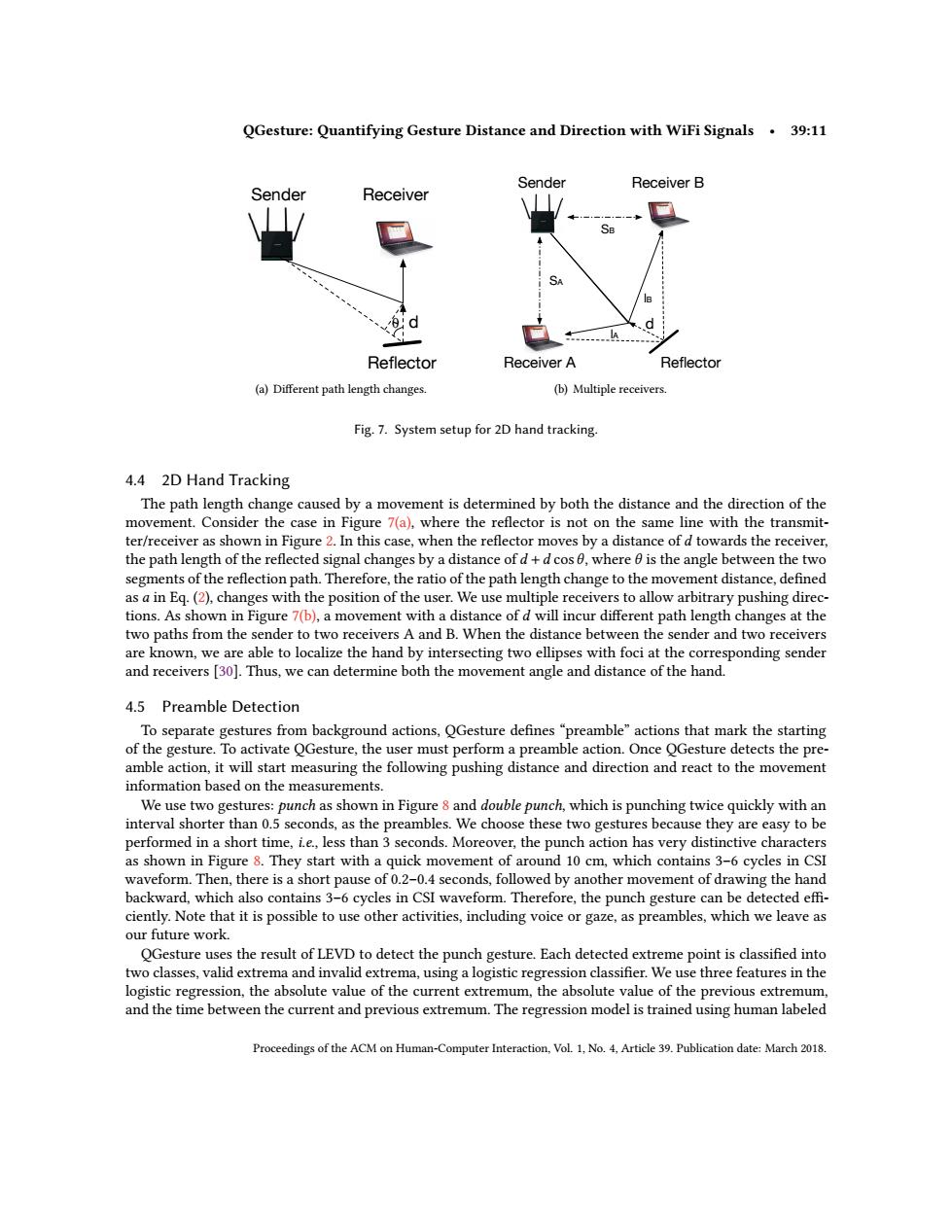正在加载图片...

QGesture:Quantifying Gesture Distance and Direction with WiFi Signals.39:11 Sender Receiver B Sender Receiver Se SA 8!d Reflector Receiver A Reflector (a)Different path length changes. (b)Multiple receivers. Fig.7.System setup for 2D hand tracking. 4.4 2D Hand Tracking The path length change caused by a movement is determined by both the distance and the direction of the movement.Consider the case in Figure 7(a),where the reflector is not on the same line with the transmit- ter/receiver as shown in Figure 2.In this case,when the reflector moves by a distance of d towards the receiver the path length of the reflected signal changes by a distance of d+d cos0,where 0 is the angle between the two segments of the reflection path.Therefore,the ratio of the path length change to the movement distance,defined as a in Eq.(2),changes with the position of the user.We use multiple receivers to allow arbitrary pushing direc- tions.As shown in Figure 7(b),a movement with a distance of d will incur different path length changes at the two paths from the sender to two receivers A and B.When the distance between the sender and two receivers are known,we are able to localize the hand by intersecting two ellipses with foci at the corresponding sender and receivers [30].Thus,we can determine both the movement angle and distance of the hand. 4.5 Preamble Detection To separate gestures from background actions,QGesture defines "preamble"actions that mark the starting of the gesture.To activate QGesture,the user must perform a preamble action.Once QGesture detects the pre- amble action,it will start measuring the following pushing distance and direction and react to the movement information based on the measurements. We use two gestures:punch as shown in Figure 8 and double punch,which is punching twice quickly with an interval shorter than 0.5 seconds,as the preambles.We choose these two gestures because they are easy to be performed in a short time,i.e.,less than 3 seconds.Moreover,the punch action has very distinctive characters as shown in Figure 8.They start with a quick movement of around 10 cm,which contains 3-6 cycles in CSI waveform.Then,there is a short pause of 0.2-0.4 seconds,followed by another movement of drawing the hand backward,which also contains 3-6 cycles in CSI waveform.Therefore,the punch gesture can be detected effi- ciently.Note that it is possible to use other activities,including voice or gaze,as preambles,which we leave as our future work. QGesture uses the result of LEVD to detect the punch gesture.Each detected extreme point is classified into two classes,valid extrema and invalid extrema,using a logistic regression classifier.We use three features in the logistic regression,the absolute value of the current extremum,the absolute value of the previous extremum. and the time between the current and previous extremum.The regression model is trained using human labeled Proceedings of the ACM on Human-Computer Interaction,Vol.1,No.4,Article 39.Publication date:March 2018.QGesture: Quantifying Gesture Distance and Direction with WiFi Signals • 39:11 Sender Receiver d Reflector ! (a) Different path length changes. Receiver A Sender d Reflector Receiver B lB lA SA SB (b) Multiple receivers. Fig. 7. System setup for 2D hand tracking. 4.4 2D Hand Tracking The path length change caused by a movement is determined by both the distance and the direction of the movement. Consider the case in Figure 7(a), where the reflector is not on the same line with the transmitter/receiver as shown in Figure 2. In this case, when the reflector moves by a distance of d towards the receiver, the path length of the reflected signal changes by a distance of d +d cos θ, where θ is the angle between the two segments of the reflection path. Therefore, the ratio of the path length change to the movement distance, defined as a in Eq. (2), changes with the position of the user. We use multiple receivers to allow arbitrary pushing directions. As shown in Figure 7(b), a movement with a distance of d will incur different path length changes at the two paths from the sender to two receivers A and B. When the distance between the sender and two receivers are known, we are able to localize the hand by intersecting two ellipses with foci at the corresponding sender and receivers [30]. Thus, we can determine both the movement angle and distance of the hand. 4.5 Preamble Detection To separate gestures from background actions, QGesture defines “preamble” actions that mark the starting of the gesture. To activate QGesture, the user must perform a preamble action. Once QGesture detects the preamble action, it will start measuring the following pushing distance and direction and react to the movement information based on the measurements. We use two gestures: punch as shown in Figure 8 and double punch, which is punching twice quickly with an interval shorter than 0.5 seconds, as the preambles. We choose these two gestures because they are easy to be performed in a short time, i.e., less than 3 seconds. Moreover, the punch action has very distinctive characters as shown in Figure 8. They start with a quick movement of around 10 cm, which contains 3–6 cycles in CSI waveform. Then, there is a short pause of 0.2–0.4 seconds, followed by another movement of drawing the hand backward, which also contains 3–6 cycles in CSI waveform. Therefore, the punch gesture can be detected efficiently. Note that it is possible to use other activities, including voice or gaze, as preambles, which we leave as our future work. QGesture uses the result of LEVD to detect the punch gesture. Each detected extreme point is classified into two classes, valid extrema and invalid extrema, using a logistic regression classifier. We use three features in the logistic regression, the absolute value of the current extremum, the absolute value of the previous extremum, and the time between the current and previous extremum. The regression model is trained using human labeled Proceedings of the ACM on Human-Computer Interaction, Vol. 1, No. 4, Article 39. Publication date: March 2018